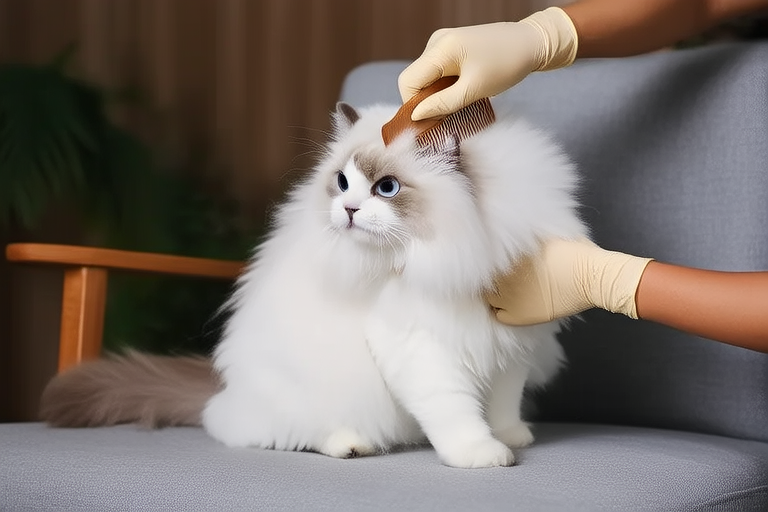
Grooming Persian Cats: A Step-by-Step Guide
Keeping your Persian cat well-groomed is essential for maintaining their shiny, healthy coat and ensuring they remain happy and healthy. This guide will walk you through the process of grooming your Persian cat, providing you with all the necessary information to keep them looking their best.
The Importance of Regular Grooming
Regular grooming is crucial for your Persian cat’s overall health and well-being. It helps to remove loose hair, prevent matting, and reduce shedding, which can be particularly beneficial for allergy sufferers. Additionally, grooming provides an opportunity to check for any skin issues or parasites, ensuring early detection and treatment. Moreover, it strengthens the bond between you and your cat, making it a positive experience for both of you.
Tools Needed for Grooming
- Brushes: Invest in a slicker brush, a comb, and a pin brush. The slicker brush is excellent for removing tangles and loose fur, while the comb and pin brush help distribute natural oils throughout the coat.
- Scissors: Keep a pair of small, sharp scissors handy for trimming longer hairs around the eyes, paws, and tail.
- Cat Shampoo: Use a gentle, pH-balanced shampoo specifically designed for cats to avoid irritating their sensitive skin.
- Dryer: A low-heat dryer can be used to dry your cat after bathing, but ensure it’s set to a comfortable temperature to avoid overheating.
- Towel: Have a soft towel ready to gently pat your cat dry after bathing.
- Toothbrush and Toothpaste: Maintain your cat’s dental hygiene with a toothbrush and toothpaste made for felines.
- Eyewipes: Clean your cat’s eyes regularly to prevent tear staining and infections.
- Ear Cleaner: Use a veterinarian-recommended ear cleaner to keep your cat’s ears clean and free from debris.
- Nail Clippers: Trim your cat’s nails every few weeks to avoid overgrowth and discomfort.
Bathing Techniques
Bathing your Persian cat should be done sparingly, ideally only when necessary. Over-bathing can strip their coat of its natural oils, leading to dryness and irritation. Here’s how to bathe your cat:
- Prepare: Fill a sink or bathtub with lukewarm water. Ensure the area is warm and comfortable for your cat. Place a non-slip mat at the bottom to prevent slipping.
- Shampoo: Wet your cat thoroughly, then apply a small amount of cat-specific shampoo. Work it into a lather, focusing on areas prone to dirt, such as the face and paws. Avoid getting shampoo in their eyes, ears, and nose.
- Rinse: Thoroughly rinse your cat to remove all traces of shampoo. Pay special attention to areas where soap may have been missed.
- Dry: Pat your cat dry with a soft towel. If necessary, use a low-heat dryer on a gentle setting, keeping it at a safe distance from your cat’s body.
Brushing Frequency and Methods
Persian cats require frequent brushing due to their long, dense coats. Aim to brush your cat at least three times a week, more often if they are shedding heavily. Follow these steps:
- Start with the Slicker Brush: Begin by using the slicker brush to remove any loose hair and prevent matting. Work in the direction of the hair growth, being gentle around sensitive areas like the belly and legs.
- Use the Pin Brush: After the slicker brush, use the pin brush to smooth out the coat and distribute natural oils. This step enhances the shine and texture of the fur.
- Comb Through: Finally, use the comb to ensure there are no remaining tangles or knots. Be patient and gentle, especially if your cat is prone to matting.
Nail Care
Trimming your Persian cat’s nails is essential to prevent overgrowth and potential pain. Here’s how to do it:
- Inspect: Check your cat’s nails regularly for signs of overgrowth or damage. Look for any changes in color or shape that might indicate a problem.
- Trim: Use a pair of sharp nail clippers to trim the tips of your cat’s nails. Be careful not to cut too close to the quick, which can cause bleeding and discomfort. If you’re unsure, consult your veterinarian for guidance.
- File: After trimming, gently file the edges of the nails to smooth them out and prevent snagging.
Ear Cleaning
Maintaining your Persian cat’s ear health is important for preventing infections and discomfort. Here’s how to clean their ears:
- Inspect: Check your cat’s ears regularly for signs of redness, discharge, or odor, which may indicate an infection.
- Clean: Using a veterinarian-recommended ear cleaner, gently massage the base of the ear to work the solution down the ear canal. Allow your cat to shake their head to dislodge any debris.
- Dry: Wipe the outer part of the ear with a cotton ball or soft cloth to remove any excess solution and debris.
Dental Hygiene
Good dental hygiene is vital for your Persian cat’s overall health. Here’s how to maintain it:
- Brush: Use a toothbrush and toothpaste made for cats to brush your cat’s teeth daily. Focus on the gum line and the outside surfaces of the teeth.
- Chew Toys: Provide your cat with chew toys designed to promote dental health. These can help reduce plaque and tartar buildup.
- Veterinary Check-ups: Schedule regular dental check-ups with your veterinarian to monitor your cat’s oral health and address any issues promptly.
Tips for Dealing with Common Grooming Challenges
Matt Prevention
Persian cats are prone to matting due to their long, thick coats. To prevent this, brush your cat frequently and carefully. If you encounter a stubborn mat, try to separate it gently with your fingers before attempting to cut it out. Always consult a professional groomer if you’re unsure about handling mats.
Tear Staining
Tear staining is a common issue in Persian cats, especially those with lighter fur. To minimize staining, keep your cat’s face clean and dry. Wipe away any excess tears with a damp cloth or eyewipes. Consider using a product specifically designed to reduce tear staining, but always consult your veterinarian first.
Benefits of Proper Grooming
Proper grooming offers numerous benefits for both your Persian cat and yourself. Regular grooming promotes a healthy coat, prevents skin issues, and strengthens the bond between you and your cat. It also helps detect any underlying health problems early, allowing for prompt treatment. By taking the time to groom your Persian cat, you’re investing in their well-being and enhancing their quality of life.




